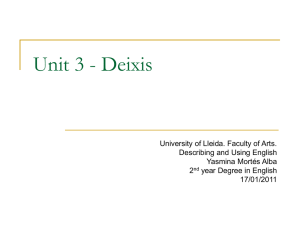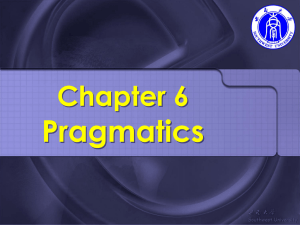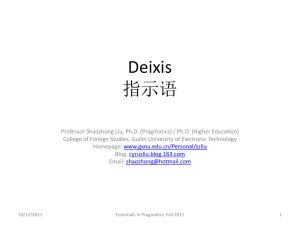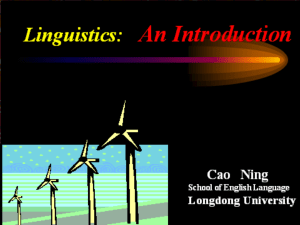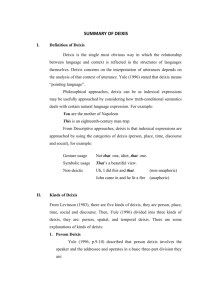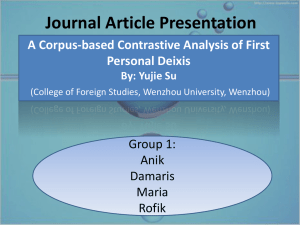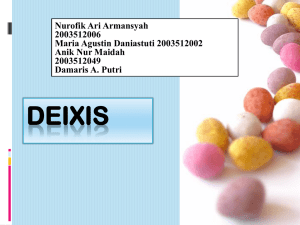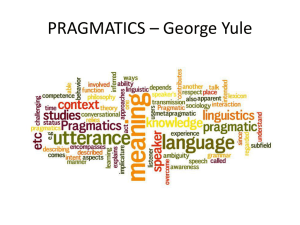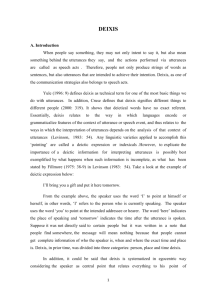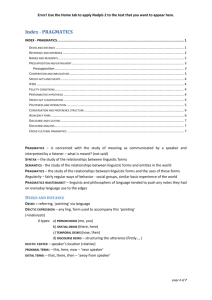Paper Deixis - WordPress.com
advertisement
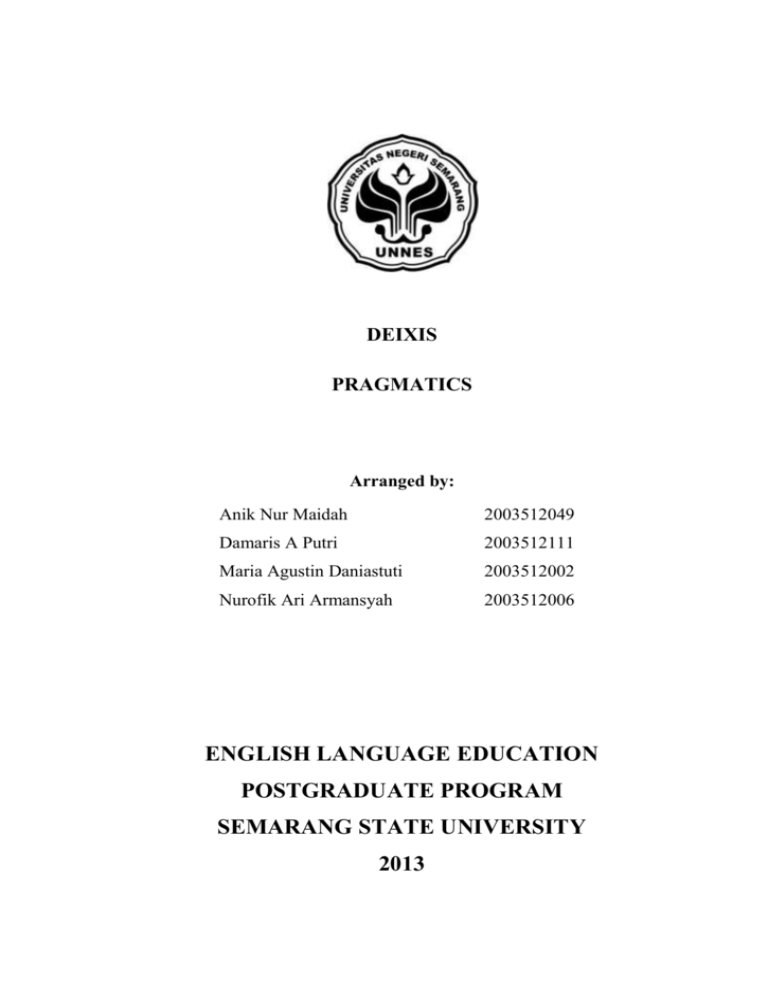
DEIXIS PRAGMATICS Arranged by: Anik Nur Maidah 2003512049 Damaris A Putri 2003512111 Maria Agustin Daniastuti 2003512002 Nurofik Ari Armansyah 2003512006 ENGLISH LANGUAGE EDUCATION POSTGRADUATE PROGRAM SEMARANG STATE UNIVERSITY 2013 I. INTRODUCTION a. Philosophical Approaches Indexical expressions may be usefully approached by considering how truth-conditional semantics deals with certain natural language expression. ex: - You are the mother of Napoleon - This is an eighteenth-century man-trap. - Mary is i n love with that fellow over there. - It is now 12.15 b. Descriptive Approach Indexical expressions are approached by using the categories of deixis (person, place, time, discourse and social) Gesture usage Not that one, idiot, that one. Symbolic usage That’s a beautiful view. Non-deictic Uh, I did this and that. (non-anaphoric) John came in and he lit a fire (anaphoric) II. DEFINITION OF DEIXIS Deixis is the single most obvious way in which the relationship between language and context is reflected in the structures of languages themselves. Deixis concerns on the interpretation of utterances depends on the analysis of that context of utterance. It reference by means of an expression whose interpretation is relative to the (usually) extralinguistic context of the utterance, such as: who is speaking the time or place of speaking the gestures of the speaker, or the current location in the discourse. Examples (English) Here are examples of deictic expressions: I You Now There That The following Tenses III. KINDS OF DEIXIS A. Person Deixis Person deixis can contain other meaning elements like the gender of the third person. Person deixis concerns with the encoding of the role of participants in the speech even in which the utterance in question is delivered. Yule (1996, p.9-10) describe that person deixis involves the speaker and the addressee and operates in a basic threepart division they are: a. First person (I). The first person deixis is a reference that refers to the speaker or both speaker and referent grouped with the speaker which is expressed in singular pronouns (I, me, myself, mine) and plural pronouns (we, us, ourselves, our, ours). The first person deixis can be divided into exclusive first person deixis, which refers to a group including addressee. b. Second person (you). The second person deixis is a deictic reference to a person or persons identified as addressee, such as you, yourself, yourselves, your, yours. c. The third person (He, She, It). Third person deixis is a deictic reference to a referent(s) not identified as the speaker or addressee and usually imply to the gender that the utterance refers to, for example: he, she, and they, him, himself, her, herself. B. Place Deixis Place deixis is also described as spatial deixis, where the relative location of people and things is being indicated. Place deixis or spatial deixis usually expressed in this, these, there, here, that, and those. Place deixis can be described along many of the same parameters that apply to the time deixis. Therefore, those references to place can be absolute or relational in nature. Absolute references to place locate an object or person in a specific longitude and latitude, while relational references locate people and place in terms of each other and the speaker. Levinson (1983, p.79) stated that place or space deixis concerns for the specification of locations to anchorage points in the speech event and typically the speaker, and there are two basic ways of referring objects by describing or naming them on the one hand and by locating them on the other. Alternatively, they can be deictically specified to the location of participants at the time of speaking. There are a proximal (close to the speaker) such as this, and these, and a distal (sometime close to the addressee) such as that, and those. Each may be used either as a pronoun or in a combination with noun. Grundy (1995) added that there are three degrees of proximity is by no means uncommon, with some languages distinguishing proximity to the speaker and to the addressee. They are: here (proximal), there (distal), where (and the archaic hither, hence, thither, thence, wither, whence), left, right, up, down, above, below, in front, behind, come, go, bring, and take. Briefly, place deixis is an expression used to show the location relative to the location of a participant in the speech event. C. Time Deixis Time deixis is also called as temporal deixis. Levinson (1993, p.73) said that the basis for systems of reckoning and measuring time in most languages seem to be the natural and prominent cycles of day and night, lunar months, season and years. Time deixis is reference to time relative to a temporal reference point. Typically, this point is the moment of utterance. The Example of Time Deixis => Temporal adverbs - now / then - yesterday / today / tomorrow - Distinctions in tense D. Empathetic Deixis The metaphorical use of deictic forms to indicate emotional or other psychological “distance” or “proximity” between a speaker and a referent The Example: - The use of this to indicate the speaker’s empathy - The use of that to indicate the speaker’s emotional distance (Levinson:1983) E. Discourse Deixis Discourse deixis is an expression used to refer to certain discourse that contain the utterance or as a signal and its relations to surrounding text (Levinson, 1983, p.85) It deals with the orientation in the text through the writer or the speaker, the relation of the text passages to the current utterance either as a head of time or past, forthcoming or simultaneou. Discourse deixis is deictic reference to a portion of a discourse relative to the speaker’s current location in the discourse, such as: above, below, last, previous, proceeding, next or following (usually used in texts) and this, that, there, next, last (usually used in utterances) Levinson (1983, p.85-86) added that discourse deixis should be distinguished from a related notion that of anaphora. Anaphora concerns with the use of a pronoun to refer to the same referent as some prior term. Anaphora can hold within sentences, across sentences, and across at speaking in a dialogue. F. Social Deixis Levinson (1983, p.89) stated that social deixis concerns with the aspects of sentences which reflect or establish or determined by certain realities of participants or the social situation in which the speech event occurs. They show how different social rankings and the participants of communication utter relationships within society via language. There are two basic kinds of social deixis information that seems to be encoded in language around the world. They are: - Relational social deixis - Absolute social deixis Relational social deixis is a deictic reference to some social characteristic of referrent apart from any relative ranking of referents or deictic reference to a social relationship between the speaker and addressee. In English, relational social deixis may be a lexical items (e.g. my husband, teacher, cousin, etc), pronouns (you, her). Absolute social deixis is a deictic reference usually expressed in certain forms of address which will include no comparison of the ranking of the speaker and addresse. For examples: your highness, Mr. President, your majesty, etc. IV. CONCLUSION Deixis is the single most obvious way in which the relationship between language and context is reflected in the structures of languages themselves. It concerns on the interpretation of utterances depends on the analysis of that context of utterance. Some aspects of deixis make a difference to truth conditions; this shift will coincide with the decision to restrict semantics to the truth-conditional aspects of meaning. REFERENCES Levinson, S. C. 1983. Pragmatics. Cambridge: Cambridge University Press. Grundy, P. 1995. Doing Pragmatics. London: St. Martin’s Press, Inc. Purwo, B. K. 1990. Pragmatik dan Pengajaran Bahasa. Yogyakarta: Kanisius. Yule, George. 1996. Pragmatics. New York:Oxford University Press
